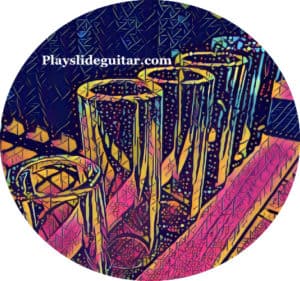Often called “open D” tuning, slide guitarists will utilize this tuning for its ample and rich sounds. The tuning lends itself well to slide technique, and many great bottleneck players have created music that has resonated with listeners using open D.
The tuning has a lot of versatility, and learning how to approach it will be helpful in creating the music you’d like to voice through it with your slide.
Playing slide guitar in open D tuning is a great way to utilize a deeper timbre than many other tunings, whether they are open or not.

Tuning
Similar to open E tuning but a whole step down, the tuning resembles a drop D tuning on guitar with many of the strings altered from standard tuning.
The lower strings (strings 6-4) will provide nice bass options when playing solo, as the intervals are a Perfect 5th and 4th respectively. Strings 4 through 1 will yield a beautiful D major chord when strummed without fretting.
This combination of the lower strings’ bass offerings, along with the major chord of the higher strings, is where this tuning shines. Approaching the tuning with this mindset can yield so much music and expression, and plenty of chordal and melodic options are available.
Here is how a guitar is tuned for open D tuning…
String 1 – D
String 2 – A
String 3 – F#
String 4 – D
String 5 – A
String 6 – D
Taking a look at the diagram below is a great way to visualize the tuning on the actual guitar and its fretboard:
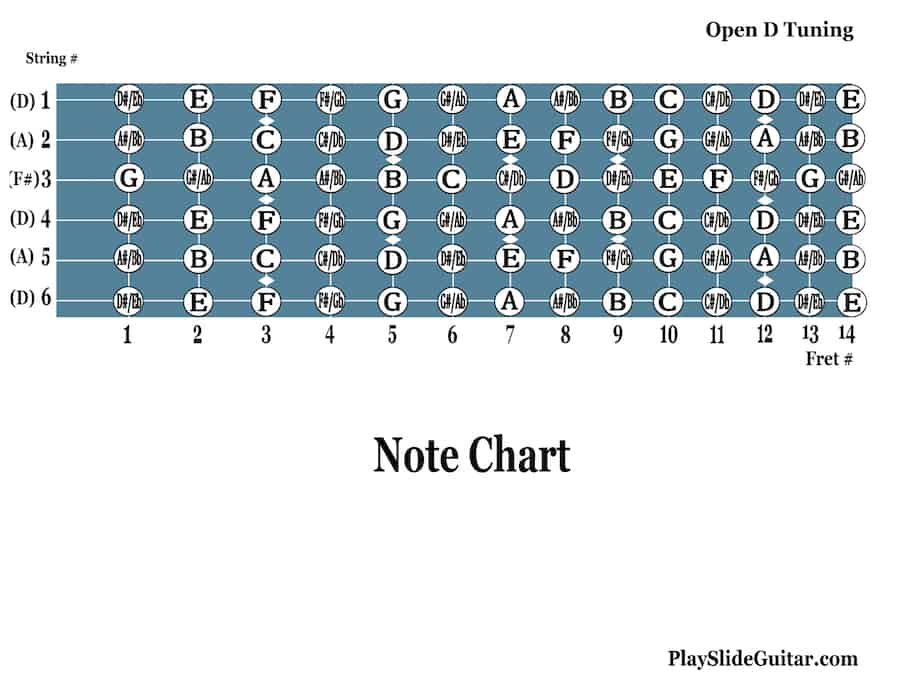
Melodic Playing
Upon first glance at the tuning, the most noticeable difference between this tuning and standard guitar tuning (where strings 6 through 1 are the following notes: EADGBD) is the open major chord on strings 4 through 1, and the bass notes on strings 6 through 4.
Adjusting to these intervals will take some practice, however don’t let this deter you from the tuning because it is actually simpler than it seems. The tuning is perhaps best approached when we break it down into pieces, and starting with the melodic options for the tuning is an appreciable avenue for beginning to create great slide music with the tuning.
Because of their rich timbre, and the slide’s ability to produce vocal-like qualities, the top 2 strings of the tuning will provide a large chunk of the playing you may want to do on the tuning.
The Two Highest Strings
Oftentimes with slide guitar, the highest two strings on tunings sound great for melodic playing. In the bottleneck tradition, these strings (especially the highest string) were amply used to create the sound that many associate with slide guitar. So much expression is possible from playing along one or two strings alone…
In fact, in the early days of bottleneck guitar many beginner players began playing slide because it was easier to play than regular guitar. It requires less learning of fretting the notes with your fingers, and they didn’t have to worry as much about getting callouses.
Using the slide on the higher strings can also be easier from a technique standpoint: there is more fluidity and freedom of movement for your sliding finger to produce the notes. Intonation and string pressure may be easier to dial in when playing less strings, and you’ll have more space below the neck to move freely.
Some of the best slide playing of the past 100 years has utilized these top two strings, and playing slide higher on the neck with them has always been a staple of slide playing (around the 12th fret is often an impactful area). This type of playing produces a bold and projecting tone, that is higher in frequency and can really cut through the music with definition and vibrancy.
Bass and Melody
Taking a similar approach to the lower strings, you can really gain some momentum with the open D tuning by utilizing the bass notes. Whether you are playing solo and providing your own rhythmic and harmonic qualities for the music, or playing chord voicings for a band, strings 6 through 4 are a great way to traverse the deeper terrains of the tuning.
A Steady Bass Line
When playing solo bottleneck guitar, or if you’d like to emphasize these notes within any type of music, creating a steady bass line can be a great accompaniment to your melodic playing. Oftentimes, the thumb is used to create quarter notes on these strings, much like a bass player does in a lot of styles of music.
Learning how to play rhythmic bass lines like this can open up a lot of doors for the tuning, or any open tuning for that matter. It will often involve a steady focus on the picking hand at first, and then when you add slide playing to the technique it will feel more natural.
As you gain facility with creating a bass line with your right hand, then combining melodic playing with the slide will feel more comfortable and expressive as you play. Putting these two pieces of slide playing together can create a lot of great slide music, and many great bottleneck tunes from the tradition are essentially these two techniques combined.
Practicing the Bass Line
It can be beneficial to spend some focused practice time on the bass line by itself, and then begin adding the other elements of your playing to it. It is still helpful to practice other techniques of slide playing as well. However, separating these techniques in your practice sessions, as well as combining them, can yield great returns.
Try practicing the bass line by itself on the open strings, using a metronome at a slower tempo at first (60-75 BPM can be a good starting point). As you become more accurate and steady, begin adding your slide once in a while to change the chord by fretting at a new location on the fretboard. It can also be helpful to tap your right foot on the ground along with the beat, especially if you’re used to doing this on standard guitar or other instruments.
If you’re playing in the key of D and utilizing the open tuning, then placing the slide at the 5th fret will create a G chord, and using it at the 7th fret will create an A chord. Playing the bass line on the open strings without any slide usage will create the D chord that the key is in. These are the basic ingredients to the bass (and some harmonic elements) for a lot of blues playing, and will open up countless doors for your slide playing.
Let’s take a closer look on how to do this with some tabs…
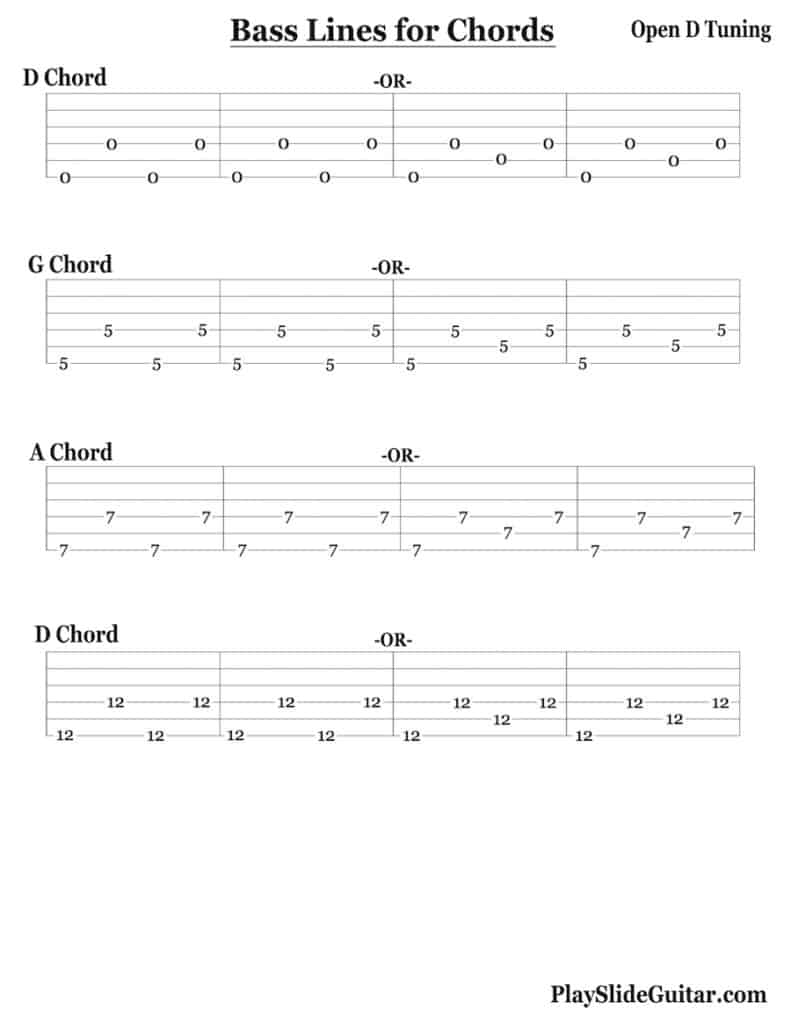
Rhythmic and Percussive Elements
When practicing this technique, you can also begin to think of it as more than just playing steady notes: try to approach it musically and with feeling. The best part of this technique, and slide playing in general, is the timing, feeling, and percussive elements that can be found within the tradition.
As your timing develops with creating a bass line, think of playing these notes from a percussive standpoint and really try to make them groove. Much like a conga or djembe player does with their hands against the heads of the drum, you can really create deep expression with your bass lines for slide guitar.
Beginning to think more dynamically, and really “patting” the notes with your thumb, can help open up this creative outlet. The open tuning offers a rich texture of sound in any position on the neck thanks to the tuning’s intervals, and you can even begin to emphasize more than one note at a time with your thumb. This will add a bit more texture to your rhythm and bass notes, and sometimes more harmonic elements can be incorporated too.
The thumb begins to act as more of a drummer and bass player combined, and you are not quite strumming the notes, but really making them jive with the soul and groove of the music.
Creating Major Chords
Because the open D tuning is naturally a major chord, an ample amount of major chord voicings are available along the guitar’s neck. Most noticeable is the D major chord when the strings are played open, and as you move along the neck with the slide, every major chord becomes readily available.
Here’s a chart that shows many of the major chords that can be created using the slide on this tuning…
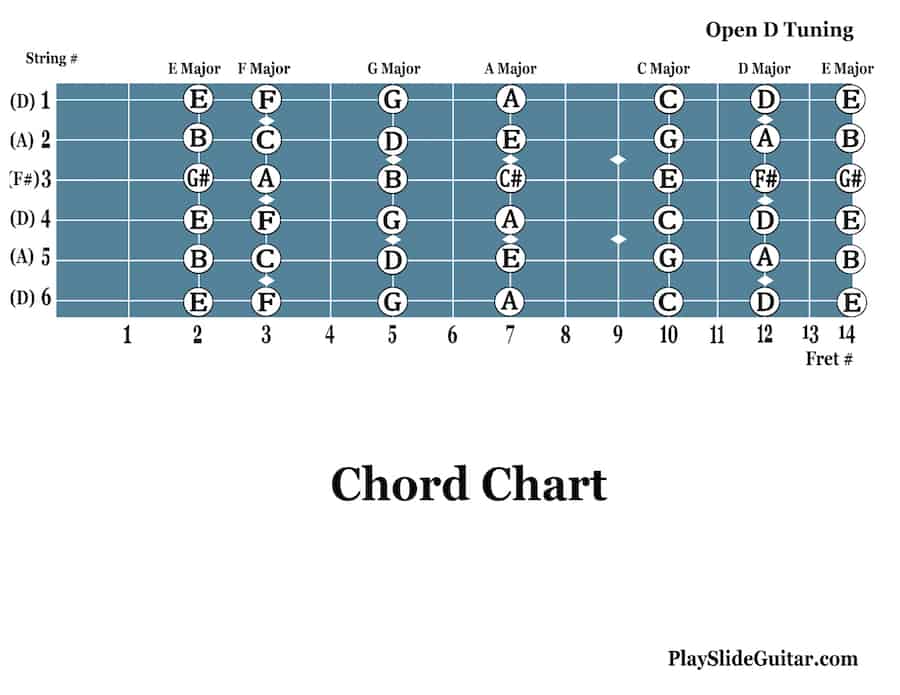
Understanding Chord Options: Relative Patterns and the Number System
For a lot of music and instruments, as well as slide guitar, understanding the relationships between chords within a key can be very beneficial and make your playing have more depth and ease at the same time.
As you begin to understand these relationships, which takes a little bit of time and awareness, they become simple to comprehend. Also, once you learn these relationships for one key, all of the other keys are the same from a relative standpoint and the patterns within the music are basically the same.
Without getting too technical, and keeping things smooth and easy, just keep in mind that these patterns or ways of understanding chords within a song or key use the number system along with the chord names. By this way, we are relating all the chords to the key of the song, or the 1 chord of the song, as well as to each other.
Playing Major Chords With The Open D Tuning
For the following examples and chord charts, we will be playing in the key of D, as the tuning lends itself well to this key because of the notes in its open position.
D Major Chords (The 1 Chord in the Key of D Major)

G Major Chords (The 4 Chord in the Key of D Major)
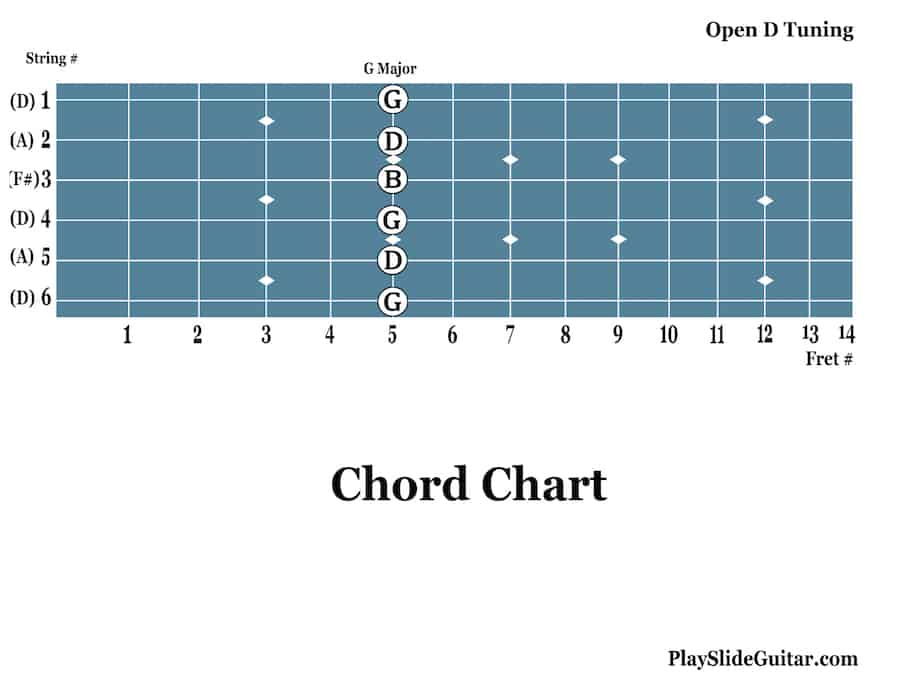
A Major Chords (The 5 Chord in the Key of D Major)
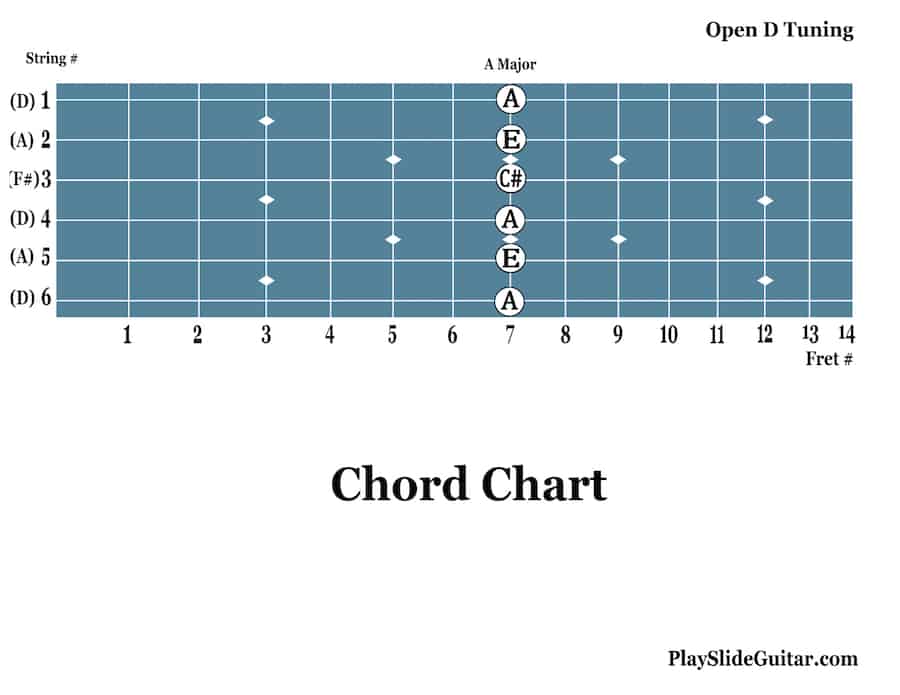
Creating Minor Chords
Although minor chords can be a little trickier to find and play in an open major tuning like open D, they are still available with a little bit of creativity and ingenuity. It can be hard to find good voicings for minor chords that contain the minor 3rd interval of the chord, however this tonality can often be implied or perceived by the listener if the chord is placed and played well within the tune.
Many times the melodic aspects of your playing can voice the minor 3rd note occasionally, which will add substance to the minor chords that you create without this interval of the chord. Also, using the minor 7th chord tones for these chords can provide richness to the chord and add life to the chord without the minor 3rd interval.
The following examples show ways of creating many minor chords within the key of D major. Many of them will not contain all of the notes of the chord, but can sound good harmonically, especially if there’s a bass player playing with you. Some of these will need to have the minor chord’s root note to be voiced prominently, in order for that chord’s tonality to be perceived as such.
E Minor Chords (The 2m Chord in the Key of D Major)
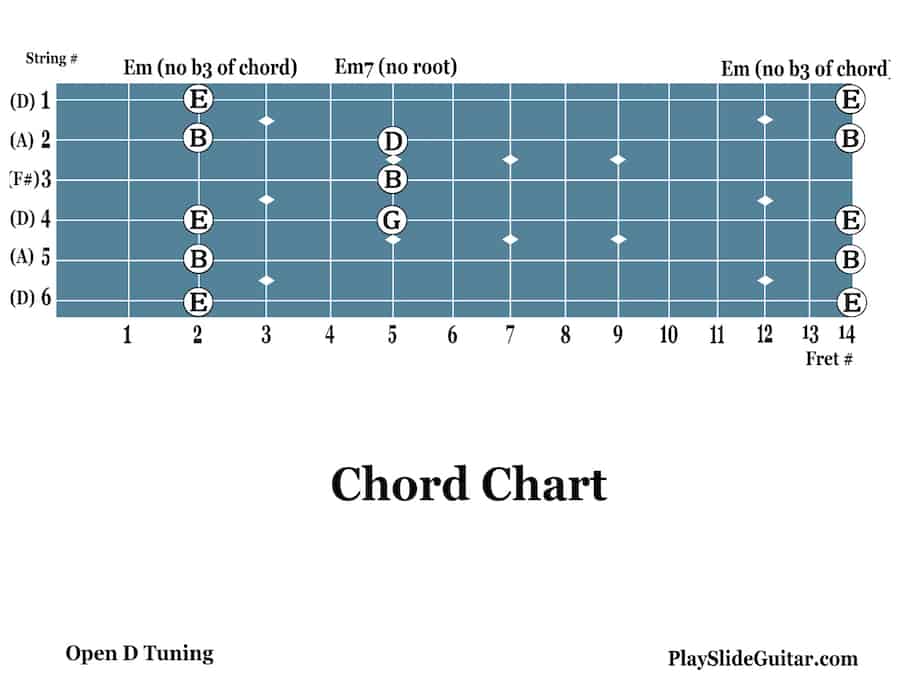
F# Minor Chords (The 3m Chord in the Key of D Major)
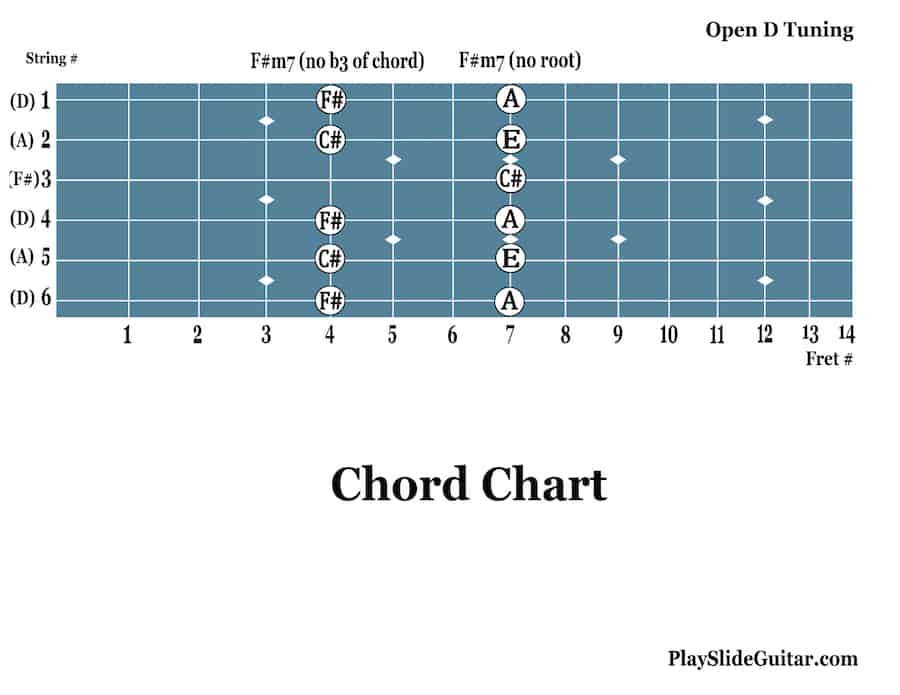
B Minor Chords (The 6m Chord in the Key of D Major)
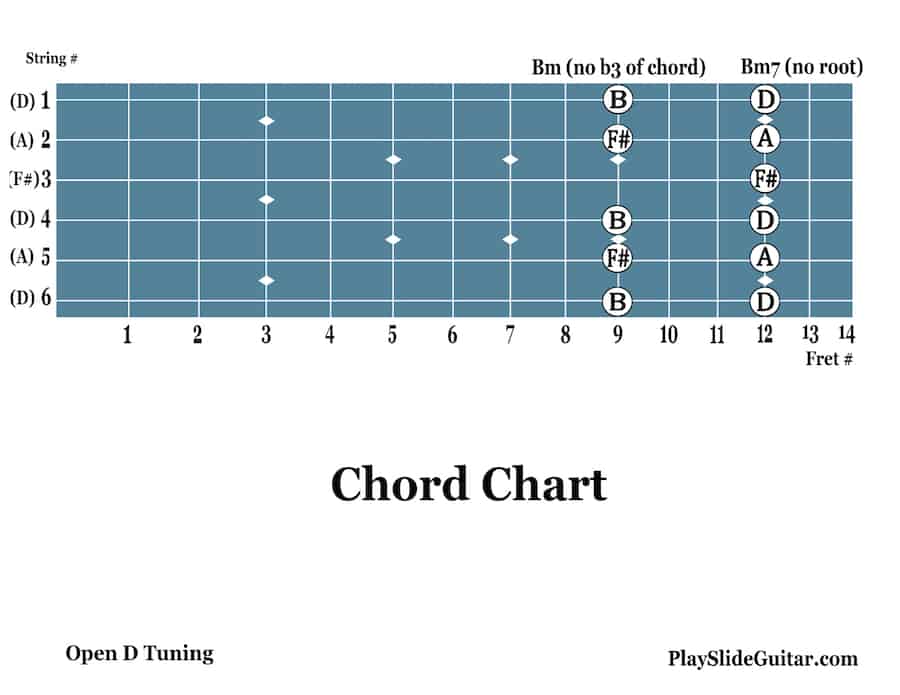
Using This Tuning On Your Instrument
Some instruments or guitars will have the open D tuning, however most of the time guitars aren’t designed specifically with this tuning in mind.
To create this tuning on a guitar that isn’t already set up for it, the guitar will often need adjustments to its nut, bridge, intonation, truss rod, and string gauges…the guitar will usually need to be setup by a professional. Note: if you decide to make any of these adjustments yourself, be careful and keep in mind that you can potentially damage your instrument, especially if it is not an electric guitar!
A professional guitar luthier or repairmen can usually setup your guitar for the tuning you’d like to employ on it, and get it adjusted so that it plays smoothly for slide guitar techniques.
Conclusion
The open D tuning is one of the most enjoyable tunings to use for slide guitar, and has a particular depth and richness to it. It is no wonder that the bottleneck tradition and slide guitarists have often utilized it, and diving deeper into playing it can be very rewarding.
